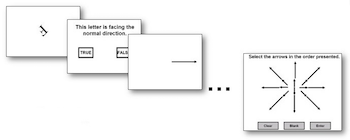Shortened Versions
The Shortened versions of the complex span tasks were designed to shorten the administration time of the tasks without decreasing their reliability and validity.
The Foster Shortened versions allows the reseacher to choose the number of blocks administered. The options are 1, 2, or 3 blocks (3 blocks would be the same as the Standard versions). The memory set-sizes are the same as the Standard versions. See below for more information on the Foster Shortened versions
The Oswald Shortened versions administers 2 blocks with reduced number of set-sizes (The highest set-size in the Standard version is not administered in these tasks). See below for more information on the Oswald Shoretened versions
Symmetry Span

Memory Task: Square Locations
Processing task: Symmetry Judgement
Operation Span

Memory Task: Letters
Processing task: Math Operations
Rotation Span

Memory Task: Arrow Direction and Size
Processing task: Mental Rotation
Foster Shortened Versions
Shortened complex span tasks can reliably measure working memory capacity. Memory and Cognition
Our shortened complex span tasks allow the researcher to indicate how many blocks (out of 3) they want to use for each task. Using a single complex span task is not appropriate for measuring working memory capacity as a construct - and we strongly suggest using multiple tasks if you would like to obtain a reliable and valid estimate of working memory capacity (these are true of both the original and shortened versions of our tasks). Thus the shortened tasks are designed to be used together to allow researchers to obtain a valid estimate of working memory capacity while taking less time than using the full-length versions of all tasks.
In our recently published paper, a graph and other data are presented that show how much time certain combinations of blocks of tasks take along with how reliable and valid these combinations are. We strongly recommend taking a look at the paper if you want to use the shortened tasks.
Oswald Shoretened Versions
Automated operation, symmetry, and reading spans described elsewhere (Unsworth et al., 2005,Memory; Unsworth et al., 2009, Memory; Redick et al., 2012, European Journal of Psychological Assessment) were modified in the following ways:
- For operation and reading span, instead of presenting 15 trials (3 each of list lengths 3, 4, 5, 6, & 7) with a maximum possible score of 75, 6 trials are presented (2 each of list lengths 4, 5, & 6) with a maximum possible score of 30
- For symmetry span, instead of presenting 12 trials (3 each of list lengths 2, 3, 4, & 5) with a maximum possible score of 42, 6 trials are presented (2 each of list lengths 3, 4, & 5) with a maximum possible score of 24.
- For all tasks, the number of storage-only and processing-and storage practice trials is 2 (versus 4 and 3, respectively).
Normative data:
Currently, there are no normative data available for these versions of the tasks. Study 2 of Oswald et al. (2015) contains descriptive statistics and correlations from a sample of N = 172 Purdue University undergraduates.
